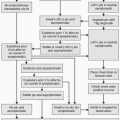Visceral Aneurysms
David M. Hovsepian
Sebastian Kos
Visceral arterial aneurysms (VAA) are rare entities, occurring in approximately 2% of the population, based on autopsy series. Most commonly, VAA are discovered in asymptomatic patients during cross-sectional imaging, suggesting that their prevalence may actually be higher than previously estimated. More importantly, 22% of patients with VAA present with leak or rupture—true emergencies that have a mortality rate of 8.5% (1).
Criteria for intervention are based on whether all three layers of the arterial wall are involved (true aneurysms) or not (pseudoaneurysms). True aneurysms are treated based on their size, location, and symptoms, whereas all pseudoaneurysms require treatment due to significantly higher rates of rupture (˜25%) and mortality (˜50%) (2,3).
1. Idiopathic
2. Atherosclerosis
3. Hereditary disorders complicated by cystic medial necrosis (e.g., Ehlers-Danlos type IV, Marfan syndrome) or arteriopathy (neurofibromatosis type 1 [NF-1])
4. Segmental arterial mediolysis
5. Fibromuscular dysplasia
6. Blunt or penetrating trauma—includes iatrogenic injuries
7. Inflammatory
a. Proteolytic degradation, for example, pancreatitis
8. Infection
a. Direct invasion
b. Septic emboli from intravenous (IV) drug abuse, endocarditis
9. Vasculitis
a. Polyarteritis nodosa (PAN)
b. IV amphetamine use
10. Neoplasia
Indications
Calcification of an aneurysm wall does not reduce the risk of rupture.
1. Visceral arterial aneurysms
a. Asymptomatic: size >2.0 to 2.5 cm in nonpregnant females of childbearing age or for patients about to undergo liver transplantation. Note: The American College of Cardiology and the American Heart Association guidelines indicate a treatment threshold of 2.0 cm, whereas some authors have suggested a threshold of 2.5 cm (6).
b. Increasing size
c. Symptomatic (e.g., pain, hemorrhage, renovascular hypertension)
2. Visceral artery pseudoaneurysms
a. All, including asymptomatic patients, regardless of size
Contraindications
Absolute
None
Relative
1. Contraindications to angiography
a. Anaphylactoid reactions to iodinated contrast agents (consider carbon dioxide [CO2] angiography or gadolinium as alternatives)
b. Uncorrectable coagulopathy
c. Renal insufficiency
2. Pregnancy
3. Acute or chronic infection in target area
4. Acute hyperthyroidism
5. Thyroid carcinoma and planned radioiodine administration
6. Solitary kidney affected by renal artery aneurysm/pseudoaneurysm
Preprocedure Preparation
1. Imaging assessment
a. Computed tomographic angiography (CTA) or magnetic resonance angiography (MRA) should be obtained to depict the vascular relationships, identify important congenital or postoperative variations, and define the branching anatomy.
b. Recent laboratory data should include a complete blood count (CBC), platelet count, international normalized ratio (INR), serum creatinine, and estimated glomerular filtration rate (eGFR). For patients on heparin, a partial thromboplastin time (PTT) may be indicated. For suspected vasculitis or inflammatory conditions, a C-reactive protein (CRP) should be obtained.
2. Patient preparation
a. Obtain informed consent.
b. Oral intake restrictions according to institutional guidelines (e.g., nil per os [NPO] for 6 to 8 hours for solids, 3 to 4 hours for fat-containing liquids, 1 to 2 hours for water and clear liquids). Typically, oral medications are permitted with sips of water.
c. Secure IV access.
d. Periprocedural antibiotic guidelines have not been established.
e. Attach equipment to monitor vital signs (blood pressure, heart rate, and oxygen saturation).
Procedure
1. Standard sterile skin cleansing and draping
2. Obtain arterial access. Often a guiding sheath or catheter provides more stable selective access to the visceral trunks, especially if the origins are acutely angled. Alternative routes of access, such as via the upper extremity, may also provide more favorable orientation in cases of severe downward angulation of the aortic branches.
3. Perform an aortogram if a CTA




Stay updated, free articles. Join our Telegram channel

Full access? Get Clinical Tree






